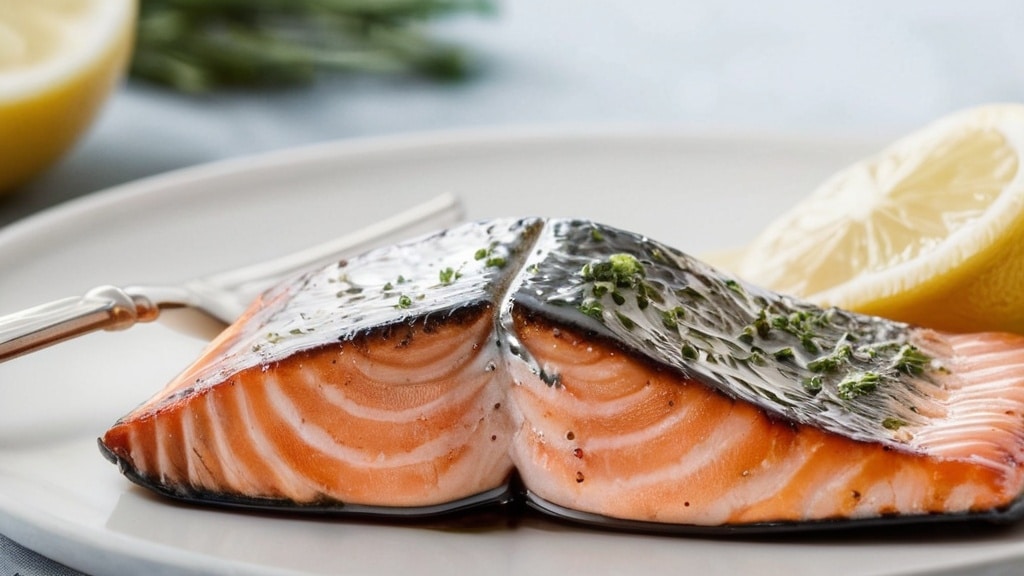The first time I smelled salmon roasting in foil, I was 9 years old, peeking into my grandmother’s old gas oven in northern British Columbia. She always swore never to roast it any other way. “Let the foil do the heavy lifting,” she’d mutter, wiping her hands on a stained tea towel, as if everyone just knew what that meant.
Turns out she was onto something. Baked salmon in foil is one of those deceptively simple recipes that hides a truckload of technique beneath its surface. It’s clean, moist, and foolproof if you do it right. Steam, fat, acid, and time, all tucked into a little silver package. Not just a meal, but a small culinary engine room, chugging away behind aluminum.
So here we are: the definitive guide to Baked Salmon in Foil, loaded with chef’s insight, tiny tricks, and plenty of room to make it your own. Whether you’re feeding picky kids or plating up for a wine-paired dinner party, this dish delivers every time.
What Is Baked Salmon in Foil, Really?
It’s more than just salmon wrapped up like leftovers.
At its core, it’s a technique called en papillote, traditionally done with parchment in French cuisine. The foil version is a home cook’s twist—tougher, more forgiving, and just as steamy. It traps moisture, flavor, and heat around the fish. This gives you salmon that’s tender but not mushy, rich but not greasy, and always aromatic.
What makes it extra special is how adaptable it is. Change one herb and it feels Mediterranean. Add ginger and sesame, and suddenly you’re halfway to Tokyo. It’s the canvas of fish cookery.
Ingredients & Substitutions
Let’s talk about what goes into the foil—and why it matters. Every piece matters. Every slice of lemon or sprig of thyme is a player in the pan.
Salmon Fillets
Go for skin-on, center-cut fillets, about 6 oz each. Wild-caught sockeye has a firmer bite and bold flavor. Atlantic is fattier, more forgiving if you slightly overcook. If you’re feeding a crowd, a side of salmon (whole slab) works great, just adjust your foil and timing.
Olive Oil or Butter
You need fat to carry flavor and help conduct heat. Olive oil gives earthiness, butter gives richness. Use a good extra virgin olive oil for clean flavor. Or use both. A drizzle of oil and a pat of butter on top? Yes, do that.
Garlic (minced or sliced)
Don’t skip it. Garlic infuses from the top down while steaming. Use fresh. Powdered garlic won’t melt into the fat the same way.
Lemon Slices or Zest
Lemon slices are classic, but zest adds sharp, fragrant oils without watering the fish. Both? Also a yes. But remove seeds—bitterness is no friend of fish.
Fresh Herbs (like Dill, Parsley, or Thyme)
Fresh herbs wilt and steam, sending their flavor straight into the fish. Dried herbs are okay in a pinch but rehydrate them in the oil first. Dill and salmon are lifelong companions, but don’t be afraid of cilantro or basil depending on your twist.
Salt & Pepper
Don’t underseason. Salt brings out the sea sweetness in the fish. Use kosher or flaky salt. Ground black pepper is fine. Cracked is better.
Optional Add-ins
– Thin-sliced fennel or onion under the fish = sweet base layer
– Cherry tomatoes = pop of acidity and juice
– Chili flakes = subtle heat
– Soy sauce + sesame oil = Asian flair
– Capers or olives = briny brightness
Step-by-Step Instructions

1. Preheat the oven to 400°F (200°C).
This temp gives you a good balance of gentle steaming and slight caramelization. Don’t go higher—foil cooking is delicate.
2. Cut foil sheets large enough to create sealed packets.
Roughly 12 x 16 inches per fillet. Heavy-duty foil is best. You don’t want leaks.
3. Drizzle olive oil or place butter on the center.
This is your flavor bed. A slick of oil keeps skin from sticking too.
4. Lay the salmon skin-side down. Season generously.
Salt, pepper, garlic, lemon zest. Be bold, but balanced. Then top with lemon slices and herbs.
5. Fold the foil into a packet.
Bring the long edges up and fold down into a tight seal, then crimp the sides. Leave a bit of space inside for steam to circulate—don’t mummify it flat.
6. Bake for 12–15 minutes, depending on thickness.
A 1-inch thick fillet takes 13 minutes. Bigger sides may take 18–20. It should flake when prodded but still glisten in the middle.
7. Rest it sealed for 2–3 minutes after removing.
This helps redistribute juices and finish gentle cooking.
8. Carefully open foil (watch for steam!).
Tilt to collect the flavorful juices—use that as your sauce.
Common Mistakes & Fixes
Overcooking
This is the biggie. Salmon keeps cooking after you pull it out. Slight underdoneness is your friend. It should feel just a little squishy in the middle.
Under-seasoning
Foil traps flavor, but you still need to layer it on. Don’t be shy with citrus, herbs, or salt.
Packet too tight or too loose
Too tight = steamed to mush. Too loose = dry edges. Aim for a sealed tent.
Using foil with acidic ingredients too long
If you prep the packets hours in advance, lemon juice can react with foil and make the fish taste metallic. If prepping ahead, wrap the fish in parchment inside the foil.
Cooking Techniques & Science
So, why does foil baking work so well?
It’s all about moist-heat cooking. Trapped steam surrounds the salmon, keeping it tender. The fat melts slowly, infusing the fish from above. Unlike dry roasting, which can leave you with chalky edges and a dry center, foil steaming is even.
Skin on or off?
Keep it on. It acts like a cooking mat and helps hold the fillet together. You can peel it off easily after baking, or crisp it under the broiler if you’re feeling fancy.
Can you use parchment instead?
Absolutely. But foil’s tighter seal and heat conduction make it better for home ovens. Parchment’s prettier for serving though, if presentation matters.
Thermometer or touch?
For pros: aim for 125°F internal temp for medium. For everyone else: gently press the top. It should spring back slightly and flake under light pressure.
Serving & Pairing Suggestions

Presentation
Open the foil at the table for a waft of warm herbs and citrus drama in the best way. Spoon some of the juices over the top. Scatter a few microgreens or herb leaves for color.
Sides that sing with it
– Lemon-herb couscous or wild rice
– Grilled asparagus, broccolini, or green beans
– A chilled cucumber-dill salad
– Crusty sourdough for sopping juices
Drinks?
– Dry Riesling or Sauvignon Blanc
– A chilled Pinot Noir (yes, really)
– Sparkling water with cucumber slices and mint
Why This Dish Matters
Baked salmon in foil isn’t flashy. It doesn’t need to be. It’s technique-forward, flavor-packed, and endlessly adaptable. It teaches restraint, timing, balance. It’s the kind of dish every serious cook should master, because it works across cuisines and seasons, whether you’re broke or bougie.
And once you nail it? You start seeing foil packets in your sleep. Trout, halibut, shrimp, even tofu. It’s a gateway.
Final Tips
– Use individual packets for faster cooking and easier serving.
– Don’t open the foil early unless you want to dry it out.
– Freeze leftover salmon and flake it into pasta or salad the next day.
– Want crispy top edges? Unwrap and broil for 2 minutes at the end. Magic.
FAQs
1. Can I prepare foil packets ahead of time?
Yes—but don’t add lemon juice until just before baking. Acid can “cook” the fish and mess with texture.
2. Can I use frozen salmon?
Thaw it first. Pat dry thoroughly to avoid a watery end result. Add 1–2 extra minutes if it’s still cold.
3. How do I know when it’s done without a thermometer?
Gently press the center with a finger or fork. It should flake easily but still look glossy in the very middle.
4. Is this method healthy?
Very. It uses minimal fat, keeps nutrients locked in, and avoids harsh browning or charring.
5. What else can I cook in foil like this?
Try white fish (cod, haddock), shrimp with garlic butter, or even tofu with miso and ginger. The method’s gold.

